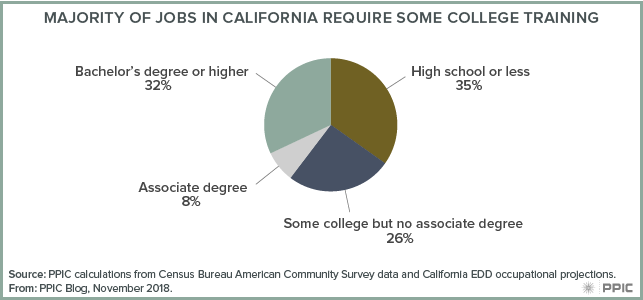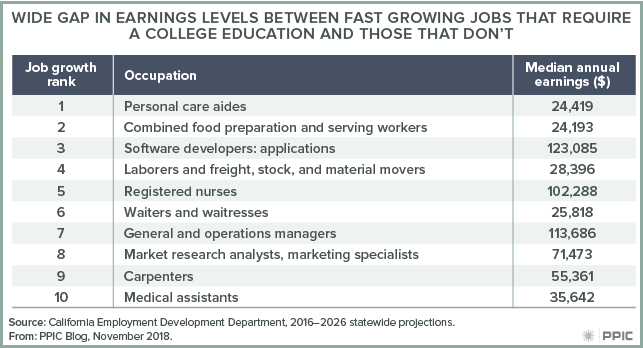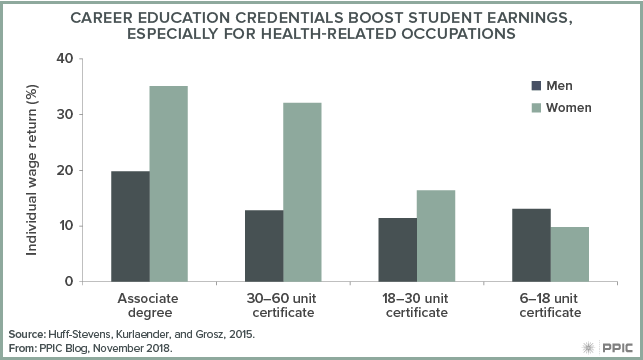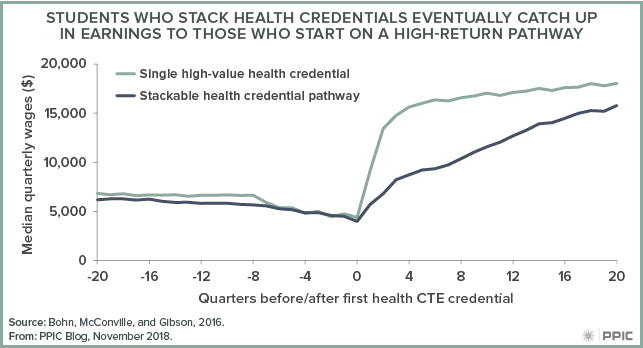Sarah Bohn, research director and senior fellow at PPIC, testified today, November 27, 2018, before the Assembly Select Committee on Career Technical Education and Building a 21st Century Workforce. Here are her prepared remarks.
Thank you for convening this informational hearing on higher education and the workforce. PPIC recently surveyed Californians on these topics and a large majority (75%) view the state’s higher education system as very important to the quality of life and economic vitality of California. Not surprisingly, the same share say that the higher education system should be a high or very high priority for the new governor. So this hearing is extremely timely and I’m so pleased to share PPIC research on education and workforce needs.
Most jobs require some college training
The majority of jobs today and in the future will require education beyond high school—split about equally between jobs that require a four-year college degree and those that require education or credentials provided at community colleges. Only about one-third of new jobs created in California over the next decade or so will be available to workers with no more than a high school diploma. These workforce needs are the result of long-term shifts toward a knowledge-based economy. It’s not just that there are new jobs that require more postsecondary education, but the need for credentials within professions has grown as well. For example, more office administrators now have a college education than in the past.

Better-paying jobs are more likely to need college training
College credentials are also the route to accessing better-paying jobs. With the trend toward a knowledge-based economy comes an increasingly wide gap in terms of earnings between jobs that require a college education and those that don’t. Among the top ten occupations in terms of job growth you find many service sector jobs that pay less than $35,000 in annual earnings (personal care aides, food preparation, freight/stock movers, medical assistants) and do not require a college education. And you find a handful of jobs at the opposite extreme—which pay three to four times as much and require a college education (registered nursing, software developers, managers). This trend is likely to continue and might become more extreme with additional pressures like AI (artificial intelligence) and further automation.

California’s community college system is key to meeting state workforce needs
Ensuring we have the workforce to meet these demands—and ensuring future workers can access higher-paying jobs—requires a higher education system that is responsive to student and economic needs. The young workers of today and tomorrow are much more diverse than the current workforce, comprised of demographic groups with historically lower levels of college attainment (including racial/ethnic minorities and first-generation college students). And though we’ve made progress, there’s still room to broaden access to college—and narrow achievement gaps.
For that reason, community colleges—and career education programs in particular—are critical to educating our future workforce. The community colleges are the most common entry point to higher education for Californians, serving almost three times as many students as CSU and UC combined. They also serve a more diverse mix of students. In career education (or CTE) programs, the majority of students are nonwhite and low income. Students range from recent high school graduates to stranded workers (who lack the skills needed to succeed in the job market) to older workers in need of retraining. And these programs provide opportunities in a wide spectrum of careers. As just one mission of the community colleges, CTE is so consequential for meeting workforce needs and improving economic outcomes because it is often the fastest route to new and better careers.
Career education programs can pay off for students
Earning credentials in CTE pays off for students. Those who earn an associate degree see a 20–35% increase in their wages. The payoff wanes for shorter credentials but remains positive even for certificates that can be earned in less than a year (certificates of 6–18 units). But the choice of program or career matters a lot. If health programs are excluded from these calculations, the payoff is much lower on average (4–7% for an associate degree). The health field offers the highest returns across all broad program types. But there’s even variation in which health programs pay off (e.g., registered nursing is more remunerative than medical assisting).

Because CTE credentials vary so much in terms of what they offer in the labor market, the choice of what to study can be as important as the choice to go to college. That information is critical for policymakers evaluating effectiveness and especially for students choosing programs. I commend the community colleges in sharing earnings potential data on their website through tools like Salary Surfer.
Some students may need new job skills to move along a career pathway to higher-paying jobs
Instead of pitting one type of credential or program against another, what we should be thinking about is improving long-term economic mobility for students. A lot of CTE students start by earning a short-term credential, which offers the lowest earnings bump, on average. But those credentials might help an individual switch to an industry with more opportunity in the long run or to start an educational career pathway toward higher-level achievement (i.e., earning “stackable” credentials). Unfortunately our research shows that only a small share of CTE programs (at most 18%) have well-defined career pathways and less than one-quarter of students who start with short-term certificates take additional steps toward broader career options.
But there’s great promise in improving those career pathways. We found that students who “stack” credentials—in this example, in a health field—eventually catch up in earnings to those who started on a high-return pathway like registered nursing. Students who earn a single health credential (mostly high-return associate degrees) see a marked improvement in their earning trajectory. Those who complete a lower-value credential but then return and complete a second one later do nearly as well. Of course this takes time (which is not free), but it’s a reminder that a single credential is not the end of the road. Effective CTE programs can connect students to in-demand and high-return careers in many ways.

In closing, this research suggests state investments in CTE are worthwhile, both for improving student career outcomes and meeting workforce needs. But the state and colleges can’t operate alone; partnership with businesses will be key to making sure that programs address workforce needs and adjust as those needs change. Only then can the state be deliberate in its investments to make sure that CTE programs improve long-term outcomes for students and the state’s economy.




